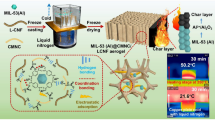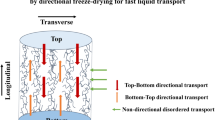Abstract
In this work, we present a new feasible way to synthesise cellulose nanocrystal (CNC) aerogel by the use of the secondary building units (organic carboxyl ligand), what had been extensively used in the building of cubic-structured metal organic frameworks (MOFs). The linear paddle-wheel structure of NHNH2–BDC–NHNH2 endows CNC aerogels with high elasticity and fast oil/water separation. The porosity and density of CNC aerogels could be regulated by different contents of NHNH2–BDC–NHNH2 and CHO–CNCs. Three mixing methods, such as vortexing, double-barrel blending and sonication, were carefully performed to investigate their formation of CNC aerogels. The density of the aerogels ranged from 22.4 to 23.3 mg/cm3 and specific surface areas were 195–303 ± 10 m2/g characterized by Brunauer–Emmett–Teller analysis. The structural analysis of scanning electron microscopy (SEM) and transmission electron microscopy (TEM) revealed the bimodal pore distribution and the hydrazone-carboxyl ligand-linked structure. On the basis of the porosity of 96.3–97.2%, the absorption capacity of aerogels was 133 ± 6 g/g for water, was 99 ± 8 g/g for ethanol, was 34 ± 4 g/g for toluene, and was 54 ± 6 g/g for dodecane. The CNC aerogels showed excellent mechanical properties and shape recovery ability in water and air. Meanwhile, the results indicate that more carboxyl on organic linkers can improve the properties of elasticity and separation for aerogels.













Similar content being viewed by others
References
Abitbol T, Johnstone T, Quinn TM, Gray DG (2011) Reinforcement with cellulose nanocrystals of poly(vinyl alcohol) hydrogels prepared by cyclic freezing and thawing. Soft Matter 7:2373–2379. doi:10.1039/c0sm01172j
Almeida Paz FA, Bond AD, Khimyak YZ, Klinowski J (2002) Synthesis and characterization of a new layered compound of trimesic acid. N J Chem 26:381–383. doi:10.1039/b108083k
Bhattacharjee S, Choi JS, Yang ST, Choi SB, Kim J, Ahn WS (2010) Solvothermal synthesis of Fe-MOF-74 and its catalytic properties in phenol hydroxylation. J Nanosci Nanotechnol 10:135–141
Biemmi E, Christian S, Stock N, Bein T (2009) High-throughput screening of synthesis parameters in the formation of the metal-organic frameworks MOF-5 and HKUST-1. Microporous Mesoporous Mater 117:111–117
Calvez G, Daiguebonne C, Guillou O (2011) Unprecedented lanthanide-containing coordination polymers constructed from hexanuclear molecular building blocks:{[Ln6O (OH) 8](NO3) 2 (bdc)(Hbdc) 2· 2NO3· H2bdc}∞. Inorg Chem 50:2851–2858
Campbell SB, Patenaude M, Hoare T (2013) Injectable superparamagnets: highly elastic and degradable poly(N-isopropylacrylamide)-superparamagnetic iron oxide nanoparticle (SPION) composite hydrogels. Biomacromolecules 14:644–653. doi:10.1021/bm301703x
Cranston ED, Eita M, Johansson E, Netrval J, Salajkova M, Arwin H, Wagberg L (2011) Determination of Young’s modulus for nanofibrillated cellulose multilayer thin films using buckling mechanics. Biomacromolecules 12:961–969. doi:10.1021/bm101330w
Dash R, Li Y, Ragauskas AJ (2012) Cellulose nanowhisker foams by freeze casting. Carbohydr Polym 88:789–792. doi:10.1016/j.carbpol.2011.12.035
Eichhorn SJ (2011) Cellulose nanowhiskers: promising materials for advanced applications. Soft Matter 7:303–315. doi:10.1039/c0sm00142b
Fateeva A et al (2010) Synthesis, structure, characterization, and redox properties of the Porous MIL-68 (Fe) solid. Eur J Inorg Chem 2010:3789–3794
Foo ML, Horike S, Fukushima T, Hijikata Y, Kubota Y, Takata M, Kitagawa S (2012) Ligand-based solid solution approach to stabilisation of sulphonic acid groups in porous coordination polymer Zr6O4 (OH) 4 (BDC) 6 (UiO-66). Dalton Trans 41:13791–13794
Fumagalli M, Sanchez F, Boisseau SM, Heux L (2013) Gas-phase esterification of cellulose nanocrystal aerogels for colloidal dispersion in apolar solvents. Soft Matter 9:11309. doi:10.1039/c3sm52062e
Furukawa H, Cordova KE, O’Keeffe M, Yaghi OM (2013) The chemistry and applications of metal-organic frameworks. Science 341:1230444. doi:10.1126/science.1230444
Ge J et al (2014) Pumping through porous hydrophobic/oleophilic materials: an alternative technology for oil spill remediation. Angew Chem Int Ed 53:3612–3616. doi:10.1002/anie.201310151
Ge J, Zhao HY, Zhu HW, Huang J, Shi LA, Yu SH (2016) Advanced sorbents for oil-spill cleanup: recent advances and future perspectives. Adv Mater. doi:10.1002/adma.201601812
Go Y, Wang X, Anokhina EV, Jacobson AJ (2004) A chain of changes: influence of noncovalent interactions on the one-dimensional structures of nickel(II) dicarboxylate coordination polymers with chelating aromatic amine ligands. Inorg Chem 43:5360–5367
Go YB, Wang X, Anokhina EV, Jacobson AJ (2005) Influence of the reaction temperature and pH on the coordination modes of the 1, 4-benzenedicarboxylate (BDC) ligand: a case study of the NiII (BDC)/2, 2′-bipyridine system. Inorg Chem 44:8265–8271
Gomez-Lor B, Gutierrez-Puebla E, Iglesias M, Monge M, Ruiz-Valero C, Snejko N (2002) In2 (oh) 3 (bdc) 1.5 (bdc = 1, 4-benzendicarboxylate): an In (iii) supramolecular 3d framework with catalytic activity. Inorg Chem 41:2429–2432
Haimer E et al (2010) Loading of bacterial cellulose aerogels with bioactive compounds by antisolvent precipitation with supercritical carbon dioxide. Macromol Symp 294(2):64–74. doi:10.1002/masy.201000008
Heath L, Thielemans W (2010) Cellulose nanowhisker aerogels. Green Chem 12:1448–1453. doi:10.1039/c0gc00035c
Jiang F, Hsieh YL (2014) Amphiphilic superabsorbent cellulose nanofibril aerogels. J Mater Chem A 2:6337–6342. doi:10.1039/c4ta00743c
Jurkowski B, Jurkowska B, Andrzejczak K (2002) On evaluation of a limit separating amorphous and crystalline states based on thermal expansion measurements. Polym Test 21:135–138
Kabiri S, Tran DNH, Altalhi T, Losic D (2014) Outstanding adsorption performance of graphene–carbon nanotube aerogels for continuous oil removal. Carbon 80:523–533. doi:10.1016/j.carbon.2014.08.092
Kaye SS, Dailly A, Yaghi OM, Long JR (2007) Impact of preparation and handling on the hydrogen storage properties of Zn4O (1, 4-benzenedicarboxylate) 3 (MOF-5). J Am Chem Soc 129:14176–14177
Klemm D, Kramer F, Moritz S, Lindstrom T, Ankerfors M, Gray D, Dorris A (2011) Nanocelluloses: a new family of nature-based materials. Angew Chem 50:5438–5466. doi:10.1002/anie.201001273
Latroche M et al (2006) Hydrogen storage in the giant-pore metal-organic frameworks MIL-100 and MIL-101. Angew Chem Int Ed 45:8227–8231
Lee J, Deng Y (2011) The morphology and mechanical properties of layer structured cellulose microfibril foams from ice-templating methods. Soft Matter 7:6034. doi:10.1039/c1sm05388d
Li H, Davis CE, Groy TL, Kelley DG, Yaghi O (1998) Coordinatively unsaturated metal centers in the extended porous framework of Zn3 (BDC) 3 ⊙ 6CH3OH (BDC = 1, 4-Benzenedicarboxylate). J Am Chem Soc 120:2186–2187
Li H, Eddaoudi M, O’Keeffe M, Yaghi OM (1999) Design and synthesis of an exceptionally stable and highly porous metal-organic framework. Nature 402:276–279
Liang HW, Guan QF, Chen LF, Zhu Z, Zhang WJ, Yu SH (2012) Macroscopic-scale template synthesis of robust carbonaceous nanofiber hydrogels and aerogels and their applications. Angew Chem 51:5101–5105. doi:10.1002/anie.201200710
Liao J-H, Huang W-C (2006) Ionic liquid as reaction medium for the synthesis and crystallization of a metal-organic framework:(BMIM) 2 [Cd 3 (BDC) 3 Br 2](BMIM = 1-butyl-3-methylimidazolium, BDC = 1, 4-benzenedicarboxylate). Inorg Chem Commun 9:1227–1231
Liebner F et al (2010) Aerogels from unaltered bacterial cellulose: application of scCO2 drying for the preparation of shaped, ultra-lightweight cellulosic aerogels. Macromol Biosci 10:349–352. doi:10.1002/mabi.200900371
Lingenfelder MA, Spillmann H, Dmitriev A, Stepanow S, Lin N, Barth JV, Kern K (2004) Towards surface-supported supramolecular architectures: tailored coordination assembly of 1, 4-benzenedicarboxylate and Fe on Cu (100). Chem Eur J 10:1913–1919
Liu C-S, Li J-R, Li C-Y, Wang J-J, Bu X-H (2007) Mn (II) coordination architectures with mixed ligands of 3-(2-pyridyl) pyrazole and carboxylic acids bearing different secondary coordination donors and pendant skeletons. Inorg Chim Acta 360:2532–2540
Ma B-Q, Mulfort KL, Hupp JT (2005) Microporous pillared paddle-wheel frameworks based on mixed-ligand coordination of zinc ions. Inorg Chem 44:4912–4914
McNamara ND, Neumann GT, Masko ET, Urban JA, Hicks JC (2013) Catalytic performance and stability of (V) MIL-47 and (Ti) MIL-125 in the oxidative desulfurization of heterocyclic aromatic sulfur compounds. J Catal 305:217–226
Miles DO, Jiang D, Burrows AD, Halls JE, Marken F (2013) Conformal transformation of [Co (bdc)(DMF)](Co-MOF-71, bdc = 1, 4-benzenedicarboxylate, DMF = N, N-dimethylformamide) into porous electrochemically active cobalt hydroxide. Electrochem Commun 27:9–13
Millange F, Walton RI, Lei L, O’Hare D (2000) Efficient separation of terephthalate and phthalate anions by selective ion-exchange intercalation in the layered double hydroxide Ca2Al (OH)6 ⊙ NO3 ⊙ 2H2O. Chem Mater 12:1990–1994
Moon RJ, Martini A, Nairn J, Simonsen J, Youngblood J (2011) Cellulose nanomaterials review: structure, properties and nanocomposites. Chem Soc Rev 40:3941–3994. doi:10.1039/c0cs00108b
Pääkkö M et al (2008) Long and entangled native cellulose I nanofibers allow flexible aerogels and hierarchically porous templates for functionalities. Soft Matter 4:2492. doi:10.1039/b810371b
Pan L, Zheng N, Wu Y, Han S, Yang R, Huang X, Li J (2001) Synthesis, characterization and structural transformation of a condensed rare earth metal coordination polymer. Inorg Chem 40:828–830
Prajapati R, Mishra L, Kimura K, Raghavaiah P (2009) Metal-organic frameworks (MOFs) constructed from Zn II/Cd II-2, 2′-bipyridines and polycarboxylic acids: synthesis, characterization and microstructural studies. Polyhedron 28:600–608
Rodenas T et al (2015) Metal-organic framework nanosheets in polymer composite materials for gas separation. Nat Mater 14:48–55. doi:10.1038/nmat4113
Sirvio J, Hyvakko U, Liimatainen H, Niinimaki J, Hormi O (2011) Periodate oxidation of cellulose at elevated temperatures using metal salts as cellulose activators. Carbohydr Polym 83:1293–1297. doi:10.1016/j.carbpol.2010.09.036
Sivakumaran D, Maitland D, Hoare T (2011) Injectable microgel-hydrogel composites for prolonged small-molecule drug delivery. Biomacromolecules 12:4112–4120. doi:10.1021/bm201170h
Smeets NM, Bakaic E, Patenaude M, Hoare T (2014) Injectable and tunable poly (ethylene glycol) analogue hydrogels based on poly (oligoethylene glycol methacrylate). Chem Commun 50:3306–3309. doi:10.1039/c3cc48514e
Sun H, Xu Z, Gao C (2013) Multifunctional, ultra-flyweight, synergistically assembled carbon aerogels. Adv Mater 25:2554–2560. doi:10.1002/adma.201204576
Tran DT, Chu D, Oliver AG, Oliver SR (2009) Synthesis and characterization of strontium 1, 3, 5-benzenetricarboxylate, [Sr 3 (1, 3, 5-BTC) 2 (H2O) 4]· H2O. Inorg Chem Commun 12:351–354
Volkringer C, Loiseau T, Férey G, Warren JE, Wragg DS, Morris RE (2007) A new calcium trimellitate coordination polymer with a chain-like structure. Solid state sci 9:455–458
Wu ZY, Li C, Liang HW, Chen JF, Yu SH (2013) Ultralight, flexible, and fire-resistant carbon nanofiber aerogels from bacterial cellulose. Angew Chem 52:2925–2929. doi:10.1002/anie.201209676
Wu ZY, Li C, Liang HW, Zhang YN, Wang X, Chen JF, Yu SH (2014) Carbon nanofiber aerogels for emergent cleanup of oil spillage and chemical leakage under harsh conditions. Sci Rep 4:4079. doi:10.1038/srep04079
Wu ZY et al (2016a) Mo2C nanoparticles embedded within bacterial cellulose-derived 3D N-doped carbon nanofiber networks for efficient hydrogen evolution. NPG Asia Mater 8:e288. doi:10.1038/am.2016.87
Wu ZY, Liang HW, Chen LF, Hu BC, Yu SH (2016b) Bacterial cellulose: a robust platform for design of three dimensional carbon-based functional nanomaterials. Acc Chem Res 49:96–105. doi:10.1021/acs.accounts.5b00380
Yang X, Cranston ED (2014) Chemically cross-linked cellulose nanocrystal aerogels with shape recovery and superabsorbent properties. Chem Mater 26:6016–6025. doi:10.1021/cm502873c
Yang X-P, Jones RA, Rivers JH, Lai RP-j (2007) Syntheses, structures and luminescent properties of new lanthanide-based coordination polymers based on 1, 4-benzenedicarboxylate (bdc). Dalton Trans 35:3936–3942
Yang X, Bakaic E, Hoare T, Cranston ED (2013) Injectable polysaccharide hydrogels reinforced with cellulose nanocrystals: morphology, rheology, degradation, and cytotoxicity. Biomacromolecules 14:4447–4455. doi:10.1021/bm401364z
Yu Y, Wu X, Guo D, Fang J (2014) Preparation of flexible, hydrophobic, and oleophilic silica aerogels based on a methyltriethoxysilane precursor. J Mater Sci 49:7715–7722. doi:10.1007/s10853-014-8480-0
Acknowledgments
The author gratefully thank the financial support of the State Key Laboratory of Heavy Oil Processing in China University of Petroleum-Beijing.
Author information
Authors and Affiliations
Corresponding authors
Ethics declarations
Conflict of interest
The authors declare no competing financial interest.
Rights and permissions
About this article
Cite this article
Ma, H., Wang, S., Meng, F. et al. A hydrazone-carboxyl ligand-linked cellulose nanocrystal aerogel with high elasticity and fast oil/water separation. Cellulose 24, 797–809 (2017). https://doi.org/10.1007/s10570-016-1132-6
Received:
Accepted:
Published:
Issue Date:
DOI: https://doi.org/10.1007/s10570-016-1132-6




